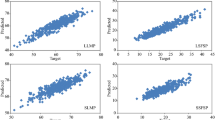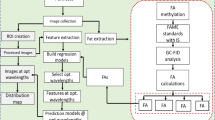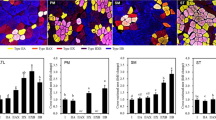Abstract
Destructured zones in the core of cooked ham are associated with PSE in terms of biochemical characteristics. In this study, the potential of near-infrared spectroscopy (NIRS) to predict the suitability of fresh pork for the production of cooked ham was investigated. Using NIR spectra obtained in a first trial (inducing PSE characteristics in Longissimus thoracis et lumborum (LTL) muscles) and in a second trial (collecting Semimembranosus (SM) samples either with or without presence of visual PSE characteristics) resulted in 93.3 and 90.0 % correct classification after cross-validation for respectively the LTL and SM samples. In a third experiment, 48 fresh hams were processed to high-quality cooked hams, sliced, and visually classified as inferior or normal quality (i.e., presence or absence of destructured zones, respectively). Measuring NIR spectra on the Biceps femoris (BF) muscle after deboning resulted in a 56.5 % correct classification after cross-validation for inferior-quality hams. It can be concluded that NIRS has potential to discriminate PSE from normal pork.


Similar content being viewed by others
References
Balac, D., Bazin, C., & Le Treut, Y. (1998). Research of the factors able to influence the appearance of the syndrome of structureless hams. Polish Journal of Food and Nutrition Sciences, 48, 45–52.
Barbut, S., Sosnicki, A. A., Lonergan, S. M., Knapp, T., Ciobanu, D. C., Gatcliffe, L. J., Huff-Lonergan, E., & Wilson, E. W. (2008). Progress in reducing the pale, soft and exudative (PSE) problem in pork and poultry meat. Meat Science, 79, 46–63.
Barlocco, N., Vadell, A., Ballesteros, F., Galietta, G., & Cozzolino, D. (2006). Predicting intramuscular fat, moisture and Warner-Bratzler shear force in pork muscle using near infrared reflectance spectroscopy. Animal Science, 82, 111–116.
Brewer, M. S., Zhu, L. G., Bidner, B., Meisinger, D. J., & McKeith, F. K. (2001). Measuring pork color: effects of bloom time, muscle, pH and relationship to instrumental parameters. Meat Science, 57, 169–176.
Castro-Giráldez, M., Botella, P., Toldrá, F., & Fito, P. (2010). Low-frequency dielectric spectrum to determine pork meat quality. Innovative Food Science Emerging Technologies, 11, 376–386.
Chen, D., Cai, W., & Shao, X. (2007). An adaptive strategy for selecting representative calibration samples in the continuous wavelet domain for near-infrared spectral analysis. Analytical and Bioanalytical Chemistry, 387, 1041–1048.
Claeys, E., De Vos, E. and De Smet, S. (2002). Protein solubility of longissimus from stress sensitive and stress resistant pigs. Proceedings 48th International Congress of Meat Science and Technology, 25th - 30th August, Rome, Italy, 479–480.
Crenwelge, D. D., Terrell, R. N., Duston, T. R., Smith, G. C., & Carpenter, Z. L. (1984). Effect of chilling method and electrical stimulation on pork quality. Journal of Animal Science, 59, 697–704.
Damez, J.-L., & Clerjon, S. (2008). Meat quality assessment using biophysical methods related to meat structure. Meat Science, 80, 132–149.
Franck, M., Bénard, G., Fernandez, X., Barbry, S., Durand, P., Lagant, H., Monin, G., & Legault, C. (1999). Observations préliminaires sur le jambon déstructuré. Journées Recherche Porcine en France, 31, 331–338.
García-Rey, R. M., García-Olmo, J., De Pedro, E., Quiles-Zafra, R., & De Castro, M. D. L. (2005). Prediction of texture and color of dry-cured ham by visible and near infrared spectroscopy using a fibre optic probe. Meat Science, 70, 357–363.
Garrido, M. D., Pedauyk, J., Bacon, S., López, M. B., & Laencina, J. (1995). On-line methods for pork quality detection. Food Control, 6, 111–113.
Geesink, G. H., Schreutelkamp, F. H., Frankhuizen, R., Vedder, H. W., Faber, N. M., Kranen, R. W., & Gerritzen, M. A. (2003). Prediction of pork quality attributes from near infrared reflectance spectra. Meat Science, 65, 661–668.
Guerrero, L., Gobantes, I., Oliver, M. A., Arnau, J., Guàrdia, M. D., Elvira, J., Riu, P., Grèbol, N., & Monfort, J. M. (2004). Green hams electrical impedance spectroscopy (EIS) measures and pastiness prediction of dry cured hams. Meat Science, 66, 289–294.
Honikel, K. O. (1987). The water binding of meat. Fleischwirtschaft, 67, 1098–1102.
Honkavaara, M. (1988). Influence of PSE pork on the quality and economics of cooked, cured ham and fermented dry sausage manufacture. Meat Science, 24(3), 201–207.
Hugenschmidt, G., Hadorn, R., Guggisberg, D., Silacci, P., Scherrer, D., Scheeder, M. R. L., & Wenk, C. (2009). Chemische und physikalische Charakterisierung von Destrukturierungen in Kochschinken. Fleischwirtschaft, 89, 86–91.
Hugenschmidt, G., Hadorn, R., Scheeder, M. R. L., Silacci, P., Scherrer, D., & Wenk, C. (2010). The effects of early post-mortem pH and ultimate pH on level and amount of destructured zones in cooked cured hams. Meat Science, 89, 632–639.
Joo, S. T., Kauffman, R. G., Kim, B. C., & Park, G. B. (1999). The relationship of sarcoplasmic and myofibrillar protein solubility to color and water-holding capacity in porcine longissimus muscle. Meat Science, 52, 291–297.
Kapper, C., Klont, R. E., Verdonk, J. M. A. J., Williams, P. C., & Urlings, H. A. P. (2012). Prediction of pork quality with near infrared spectroscopy (NIRS) 2. Feasibility and robustness of NIRS measurements under production plant conditions. Meat Science, 91, 300–305.
Kuo, C. C., & Chu, C. Y. (2003). Quality characteristics of Chinese sausages made from PSE pork. Meat Science, 64, 441–449.
van Laack, R. L. J. M., & Kauffman, R. G. (1999). Glycolytic potential of red, soft, exudative pork longissimus musle. Journal of Animal Science, 77, 22971–22973.
Laville, E., Franck, M., Sidibé, M., Sayd, T., Bonny, J. M., Chazeix, J. F., & Monin, G. (2003). Anatomical study of lesions in destructured hams. Sciences des Aliments, 23(1), 70–74.
Laville, E., Sayd, T., Santé-Lhoutellier, V., Morzel, M., Labas, R., Franck, M., Chambon, C., & Monin, G. (2005). Characterisation of PSE zones in semimembranosus pig muscle. Meat Science, 70, 167–172.
Lesiów, T., & Xiong, Y. L. (2013). A simple, reliable and reproductive method to obtain experimental pale, soft and exudative (PSE) pork. Meat Science, 93, 489–494.
McCaw, J., Ellis, M., Brewer, M. S., & McKeith, F. K. (1997). Incubation temperature effects on physical characteristics of normal, dark, firm and dry, and halothane-carrier pork longissimus. Journal of Animal Science, 75, 1547–1552.
Minvielle, B., Boulard, J., Vautier, A., & Houix, Y. (2003). Viandes déstructurées dans la filière porcine: effets combines des durées de transport et d’attente sur la fréquence d’apparition du défaut. Journées Recherche Porcine, 35, 263–268.
Murray, I. (2012). Introduction to near infrared spectroscopy. Infrared spectroscopy and chemometrics training, 27th February - 2th March, Walloon Agricultural Research Centre, Gembloux.
Pina-Barrera, A., Meza-Marquez, O., Osorio-Revilla, G., & Gallardo-Velasquez, T. (2014). Identification and quantification of corncob as adulterant in corn dough and tortilla by MIR-FTIR spectroscopy and multivariate analysis. CyTA Journal of Food, 12, 65–72.
Prieto, N., Roehe, R., Lavín, P., Batten, G., & Andrés, S. (2009). Application of near infrared reflectance spectroscopy to predict meat and meat products quality: a review. Meat Science, 83, 175–186.
Reichert, J. E. (1997). Herstellung von Roh- und Kochschinken. Meßparameter für die Automatische Selektion des Ausgangsmaterials. Fleischwirtschaft, 77, 341–344.
Ryu, Y. C., Choi, Y. M., & Kim, B. C. (2005). Variations in metabolic contents and protein denaturation of the longissimus dorsi muscle in various porcine quality classification and metabolic rates. Meat Science, 71, 522–629.
Savell, J. W., Mueller, S. L., & Baird, B. E. (2005). The chilling of carcasses. Meat Science, 70, 449–459.
Schilling, M. W., Marriott, N. G., Acton, J. C., Anderson-Cook, C., Alvarado, C. Z., & Wang, H. (2004). Utilization of response surface modeling to evaluate the effects of non-meat adjuncts and combinations of PSE and RFN pork on water holding capacity and cooked color in the production of boneless cured pork. Meat Science, 66, 371–381.
Shiroma, C., & Rodriguez-Solona, L. (2009). Application of NIR and MIR spectroscopy in quality control of potato chips. Journal of Food Composition and Analysis, 22, 596–605.
Toldrá, F., & Flores, M. (2000). The use of muscle enzymes as predictors of pork meat quality. Food Chemistry, 69, 387–395.
Tomović, V. M., Jokanović, M. R., Petrović, L. S., Tomović, M. S., Tasić, T. A., Ikonić, P. M., Šumić, Z. M., Šojić, B. V., Škaljac, S. B., & Šošo, M. M. (2013). Sensory, physical and chemical characteristics of cooked ham manufactured from rapidly chilled and earlier deboned M. semimembranosus. Meat Science, 93, 46–52.
Torley, P. J., D’Arcy, B. R., & Trout, G. R. (2000). The effect of ionic strength, polyphosphates type, pH, cooking temperature and preblending on the functional properties of normal and pale, soft, exudative (PSE) pork. Meat Science, 55, 451–462.
Utrera, M., Armenteros, M., Ventanas, S., Solano, F., & Estévez, M. (2012). Pre-freezing raw hams affects quality traits in cooked hams: potential influence of protein oxidation. Meat Science, 92, 596–603.
Van de Perre, V., Ceustermans, A., Leyten, J., & Geers, R. (2010). The prevalence of PSE characteristics in pork and cooked ham—effects of season and lairage time. Meat Science, 86, 391–397.
Vautier, A., Boulard, J., Bouyssière, M., Houix, Y., & Minvielle, B. (2008). Prediction level of meat quality criteria on “PSE-like zones” defect of pork’s ham. In Proceedings 54th International Congress of Meat Science and Technology, 10th - 15th August. Cape Town, South Africa.
Warner, R. D., Kauffman, R. G., & Greaser, M. L. (1997). Muscle protein changes post mortem in relation to pork quality traits. Meat Science, 45, 339–352.
Williams, P. C., & Norris, K. (2001). Near-infrared technology in the agricultural and food industries (second ed., ). St. Paul:American Association of Cereal Chemists, Inc..
Acknowledgments
This research could be carried out thanks to the financial support of IWT Flanders (Brussels, Belgium), Belpork npo, Belgian meat companies, and suppliers of NIR equipment. The authors would like to thank the staff of the participating slaughterhouses and meat processing companies for their assistance. Bruker (Evere, Belgium) was gratefully acknowledged for providing the Matrix F spectrophotometer. Part of the results has been presented as a poster presentation at the 59th International Conference of Meat Science and Technology (ICoMST) (Izmir, Turkey, August 18–23, 2013) (Neyrinck et al. Suitability of Near Infrared Spectroscopy as selection tool for PSE pork), and as a short communication on the COST-FAIM workshop (Taastrup, Denmark, September 25–26, 2014) (Neyrinck et al. Capability of Near Infrared Spectroscopy to predict quality of fresh pork for cooked ham production).
Author information
Authors and Affiliations
Corresponding author
Electronic Supplementary Material
ESM 1
(DOCX 35.1 kb)
Rights and permissions
About this article
Cite this article
Neyrinck, E., De Smet, S., Vermeulen, L. et al. Application of Near-Infrared Spectroscopy for the Classification of Fresh Pork Quality in Cooked Ham Production. Food Bioprocess Technol 8, 2383–2391 (2015). https://doi.org/10.1007/s11947-015-1583-z
Received:
Accepted:
Published:
Issue Date:
DOI: https://doi.org/10.1007/s11947-015-1583-z




